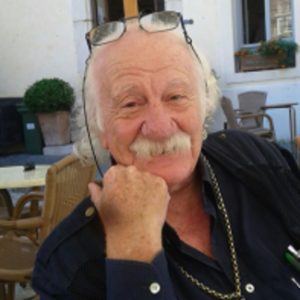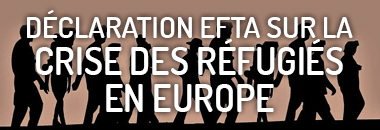EUROPEAN FAMILY THERAPY ASSOCIATION
CONNECTING FAMILY THERAPISTS AND TRAINERS
Carmine Saccu
(1939) Child neuropsychiatrist, from 1974 to 1991 he worked with Maurizio Andolfi

Cynthia Ladvocat: In the 1990’s I received Carmine Saccu at my Family therapy training institute. I was studying Italian and happy to be able to interview him in Italian, with the questions already sorted out. Behind the one way mirror the team was waiting for the interview, curious about our dialogue. When I asked the first question in Italian, he answered in Portuguese. I explained the interview could be held in Italian. He said he was learning portuguese and he wanted to exercise his portuguese. Facing this curious impasse, in his usual friendly and playful way, he said: “Oh ok ok, you want to train italian, then speak in italian. I also want to exercise my Portuguese. I will answer in portuguese”. And so this interesting and bilingual interview took place.
Around 2010, I took a group of Brazilian friend professionals to work on the Therapist’s Self at the Scuola Romana di Psicoterapia Familiare. We all knew each other, except one colleague who signed up at the last minute. This colleague stood out from the group, she was never with the others during conversations, walks or meals. We all wondered what she was doing all by herself in the streets of Rome. Everyone commented and built hypotheses about her strange behavior, but no one asked her directly.
On the first day of the course, Carmine introduced himself with his pug dog, saying that Lola was his co-therapist. Everyone was surprised by the idea of a dog participating in the course, but we all loved Lola’s presence. Carmine then asked who would like to talk about the functioning of the group, how the friendship had been built and what we would like to work on. Silence fell in the group, everyone was impacted by the question and looked at each other, each one thinking how to talk about the strange colleague. Carmine asked again if there was any particular problem, if anyone needed to talk or reveal anything. As the silence continued, Carmine said that since no one said anything, he would ask Lola to pick with her nose someone who could reveal about the group’s problem.
Lola, who was next to Carmine, walked across the room and sat down in front of the mentioned colleague that everyone had been talking about in recent days. At that moment, everyone had to contain themselves not to express their astonishment, all curious and fearful of what could happen.
Lola remained seated in front of our colleague, who started her story about the difficulties with her family. She talked about her family problems in Brazil and that she needed to try to solve them despite the distance. She told us about her recent problems since she had also lost her suitcase, so she had no clothes.
Lola, after this illuminating report, wagged her tail and affectionately asked to climb onto our colleague’s lap. Everyone in the group was relieved and thrilled. It was natural at that point to work In the group on how prejudices can be elaborated when communication can be unlocked. Very soon Lola returned to her place next to Carmine and the group could continue its work with the sensitivity and efficiency of its coordinator and of its co-therapist.
Umberta Telfener: Carmine is a great guitar player and a great dancer. Everytime there is an occasion to eat, converse and play music he is the first to participate. He usually accepts invitations to seminars both in Italy and abroad if he gets the information that there is a specific type of food in the area to try or a special plate, cooked in a very specific mode. More than once I was invited to his Institute anniversaries and found myself all dressed up in a medieval festival (for example in Assisi and Todi) or participating in a traditional carnival (in Sardegna). Every traditional festival becomes an attractor for him and you can appreciate the fun he is able to share.
Deisy Amorin-Woods: I have been fortunate to hold interviews and conversations with prominent second generation leaders of our field who have shared professional and personal experiences about themselves, and their influential mentors and pioneers in our profession. I did this for the Australian and New Zealand Journal of Systemic Family Therapy.
During the EFTA Congress, 2022 I interviewed the charismatic, and jovial ‘systemic story-teller’ Carmine Saccu. Armed with a wealth of multiple and diverse experiences of his origins and his work, he shared his engaging stories, saturated with metaphors and symbols. As I sat with him, I felt mesmerized and transported to a time as a ‘niña’ (a young child) sitting cross-legged attentively listening to the multiple and diverse stories of his deeply creative work, where he uses play, humor and fantasy,; listening to the innovative inclusion of his equally eminent canine co-therapist ‘Mafalda’ in his work with children, adolescents, and their families. Throughout our conversation, every time I approached the end of the interview, he would manage to bring me in again and easily captured my attention for yet “one more story”…
Umberta Telfener: At a recent conference in Todi, he proposed the kaleidoscope as a metaphor to indicate the differences in psychotherapeutic approaches. In order to better define the procedural aspect of many psychotherapeutic methodologies, he pointed to the kaleidoscope that his parents used to give him as a present, bought at village fairs, the characteristic of which is that, when rotated at a certain point, the first image reappears. The non-procedural kaleidoscope, on the other hand, is the one that, when rotated, never presents the same image because the colored stones inside do not follow pre-established paths. This last metaphor of the second kaleidoscope is reminiscent of Bion’s suggestion to therapists to enter the session « unsaturated » precisely because it is possible to grasp the « singularities » that are not foreseen in the hypotheses that are often formulated during the therapeutic process.
Carmine often recounts when – unexpectedly, in an attempt to resolve issues related to the feeling of powerlessness that his encounter with autistic children caused him – he encountered a ‘new paradigm’. The encounter with autistic children and children with childhood psychosis was decisive. These children are called by him “High Priests” to highlight their capacity for attention expressed at the highest level. The High Priests respond « to the principle of absolute relationality » where attention is absolute: they are in the relationship denying the relationship. If attention is absolute there is no ‘distraction’ and this makes them ‘High Priests’. Their attention is so vigilant in not entering the relationship by denying the relationship, that the psychotherapeutic approach is totally modified. The gaze is directed upwards, where they – at the top of the pyramid – are the real teachers, because they are capable of rendering everyone powerless and often incongruous. Incongruity is believing oneself to be therapeutically powerful when at another level powerlessness dominates. The high priests must be challenged with respect to their ability to ‘make believe’ that the absolute and the eternal are present on earth, by implementing therapeutic interventions that are more likely to catch the ‘carelessness’ as they too are and live in objective time on earth.
According to him, the autistic child and the child with childhood psychosis can be seen as ‘Swiss cheese’ or as parmesan cheese. These two metaphors reflect two paradigms whose development leads to two different orientations. Seeing the autistic child as Swiss cheese involves looking for all that he is lacking and deficient in, his holes. The lowest common denominator of all interventions becomes the deficiency that those holes represent. Parmesan cheese seen as a metaphor is a cheese so compact that not even light can get in. To see autistic children and psychotic children as ‘parmesan’ is to follow another paradigm opposite to that of gruyere.
Carmine told me how he arrived to become a systemic thinker. It happened in an unexpected way: in an attempt to resolve issues related to his feeling of helplessness caused by meeting autistic children, he encountered a « new paradigm », the systemic one. The meeting with autistic children and those suffering from infantile psychosis was decisive. Following systemic thinking he calls such children High Priests and thinks of them having « maximum » attention. If the attention is « absolute » there is no « distraction » and this means that they are « Supreme, High ». The High Priests respond « to the principle of absolute relationality » where attention is maximum; the aim is to « stay in the relationship while denying the relationship », it is as if they were outside objective time. If you imagine a pyramid, they occupy the top. Their gaze is no longer oriented downwards but upwards; being at the top of the pyramid they are the true teachers, because they are capable of making professionals impotent and often incongruous. Their « attention » is so vigilant in entering into relationships, while denying the relationship, that the psychotherapeutic approach is totally modified by those who deal with them in the various fields.
Umberta Telfener: At a recent conference in Todi in October 2022 – to celebrate the thirty years of his systemic school – Carmine proposed the kaleidoscope as a metaphor to indicate the differences in the psychotherapeutic approach. To better define the procedural aspect of many psychotherapeutic methodologies, he indicated the kaleidoscope that they gave him as a child and he bought at village fairs, the characteristic of which was that, by rotating it, the first image very soon reappeared in a repetitive pattern. On the other hand, the non-procedural kaleidoscope is one which, when rotated, never presents an identical image because the slides inside do not follow pre-established paths. According to Carmine this last metaphor of the second kaleidoscope recalls Bion’s suggestion to therapists to enter the session « unsaturated », precisely because it is possible to grasp « singularities » that are not foreseen in the hypotheses that are often formulated during the therapeutic process. Personally the game I often do in presence of Carmine is to allow him to bring me through our conversation and the primary process remembrances he shares to unforeseen places of my mind and to enjoy the abductive storytelling he is so generous to share.



